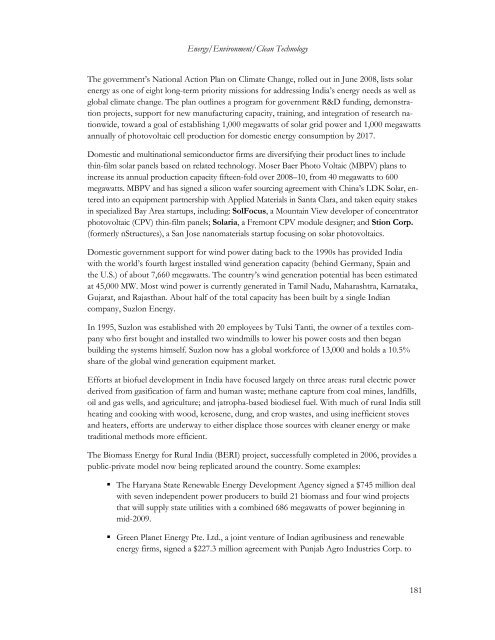PDF: 2962 pages, 5.2 MB - Bay Area Council Economic Institute
PDF: 2962 pages, 5.2 MB - Bay Area Council Economic Institute
PDF: 2962 pages, 5.2 MB - Bay Area Council Economic Institute
You also want an ePaper? Increase the reach of your titles
YUMPU automatically turns print PDFs into web optimized ePapers that Google loves.
Energy/Environment/Clean Technology<br />
The government’s National Action Plan on Climate Change, rolled out in June 2008, lists solar<br />
energy as one of eight long-term priority missions for addressing India’s energy needs as well as<br />
global climate change. The plan outlines a program for government R&D funding, demonstration<br />
projects, support for new manufacturing capacity, training, and integration of research nationwide,<br />
toward a goal of establishing 1,000 megawatts of solar grid power and 1,000 megawatts<br />
annually of photovoltaic cell production for domestic energy consumption by 2017.<br />
Domestic and multinational semiconductor firms are diversifying their product lines to include<br />
thin-film solar panels based on related technology. Moser Baer Photo Voltaic (<strong>MB</strong>PV) plans to<br />
increase its annual production capacity fifteen-fold over 2008–10, from 40 megawatts to 600<br />
megawatts. <strong>MB</strong>PV and has signed a silicon wafer sourcing agreement with China’s LDK Solar, entered<br />
into an equipment partnership with Applied Materials in Santa Clara, and taken equity stakes<br />
in specialized <strong>Bay</strong> <strong>Area</strong> startups, including: SolFocus, a Mountain View developer of concentrator<br />
photovoltaic (CPV) thin-film panels; Solaria, a Fremont CPV module designer; and Stion Corp.<br />
(formerly nStructures), a San Jose nanomaterials startup focusing on solar photovoltaics.<br />
Domestic government support for wind power dating back to the 1990s has provided India<br />
with the world’s fourth largest installed wind generation capacity (behind Germany, Spain and<br />
the U.S.) of about 7,660 megawatts. The country’s wind generation potential has been estimated<br />
at 45,000 MW. Most wind power is currently generated in Tamil Nadu, Maharashtra, Karnataka,<br />
Gujarat, and Rajasthan. About half of the total capacity has been built by a single Indian<br />
company, Suzlon Energy.<br />
In 1995, Suzlon was established with 20 employees by Tulsi Tanti, the owner of a textiles company<br />
who first bought and installed two windmills to lower his power costs and then began<br />
building the systems himself. Suzlon now has a global workforce of 13,000 and holds a 10.5%<br />
share of the global wind generation equipment market.<br />
Efforts at biofuel development in India have focused largely on three areas: rural electric power<br />
derived from gasification of farm and human waste; methane capture from coal mines, landfills,<br />
oil and gas wells, and agriculture; and jatropha-based biodiesel fuel. With much of rural India still<br />
heating and cooking with wood, kerosene, dung, and crop wastes, and using inefficient stoves<br />
and heaters, efforts are underway to either displace those sources with cleaner energy or make<br />
traditional methods more efficient.<br />
The Biomass Energy for Rural India (BERI) project, successfully completed in 2006, provides a<br />
public-private model now being replicated around the country. Some examples:<br />
• The Haryana State Renewable Energy Development Agency signed a $745 million deal<br />
with seven independent power producers to build 21 biomass and four wind projects<br />
that will supply state utilities with a combined 686 megawatts of power beginning in<br />
mid-2009.<br />
• Green Planet Energy Pte. Ltd., a joint venture of Indian agribusiness and renewable<br />
energy firms, signed a $227.3 million agreement with Punjab Agro Industries Corp. to<br />
181








